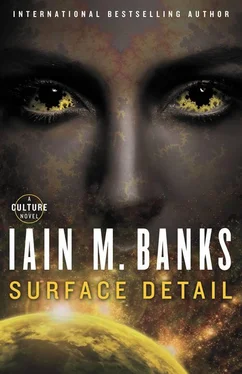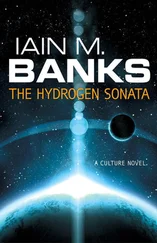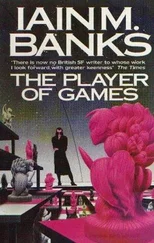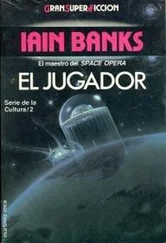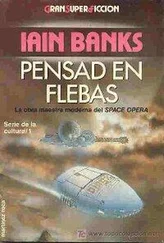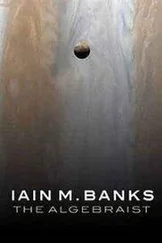Despite this, Yime lived in a city, and although the construction she lived in was fairly substantial — a kilometre tall and perhaps a tenth of that across — it itself was not the totality of the metropolis, forming only a small part of it and being nowhere near the most impressive of its buildings. But then it was nowhere near any of the other buildings of the city. The building was part of a Distributed City, which to the naive or uninformed eye looked remarkably like no city whatsoever.
Most Culture cities, where they existed at all, resembled giant snowflakes, with greenery — or at least countryside, in whatever colour or form — penetrating almost to the heart of the conurbation.
Had its major buildings been gathered together on the same patch of ground, this city, Irwal, on the Orbital called Dinyol-hei, would have looked more like some vision of the far future from sometime in the enormously distant past; it was almost entirely composed of great soaring sleek skyscrapers hundreds or thousands of metres tall, generally slimly conical or ellipsoid in appearance and looking uncannily like ships, or starships, as they had once been called. Fittingly, the buildings were exactly that: ships, fully capable of existing and making their way in space, between stars, should the need ever arise.
All the thousand or so major cities on Dinyol-hei were composed in the same way, from hundreds of giant buildings that could happily double as spacecraft. It was a truism that as a scientific society progressed, its ships gradually ceased to be strictly utilitarian designs in which almost every part was in some way vital to the running of the craft. Normally they went through an intermediate stage where the overall conception was still limited by the necessities imposed by the environment in which the vessels travelled but within which there was considerable opportunity for the designers, crew and passengers/inhabitants to fashion them pretty much as they pleased, before — usually some centuries after the gross vulgarity of rocket power — simple space travel became so mature a technology it was almost trivial. At this point, practically anything not messily joined to lots of other important stuff could be quite easily turned into a space-capable craft able to transport humans — or any other species spectacularly maladapted to hard vacuum and the somewhat industrial radiation environment generally associated with it — to (at the very least) different parts of the same stellar system.
A stand-alone building was almost laughably easy to convert; a bit of strengthening and rigidising, some only semi-scrupulous sealant work, throw a gel coat over the whole thing as well just to be doubly sure, strap on an engine unit or two somewhere, and you were away. In the Culture, you could even dispense with sensory and navigation systems; stay within a light year or two of the nearest Orbital and you could navigate with your own neural lace, even an antique pen terminal. It was DIY space travel, and people did exactly that, though — always to the surprise of those just on the brink of contributing to the relevant statistics — the results made it one of the more dangerous hobbies pursued with any enthusiasm within the Culture.
The means, then, were readily to hand. The motive behind the sort of building Yime now stood in was simply survival; should some catastrophe befall the Orbital itself, its inhabitants could escape the place in what were essentially giant lifeboats.
The principle had swung in and out of fashion. At one point very early in the Culture’s history, many thousands of years ago, such high-redundancy safety consciousness had been the fairly strictly followed rule. It fell from favour as habitat and especially Orbital design, construction and protection rose to levels that pretty much guaranteed that those who lived in them had nothing catastrophic to worry about, then came very rapidly back into fashion when the Idiran war had gone from being an almost unthinkable absurdity through being an unlikely joke to — seemingly without warning — becoming a terrifyingly tangible reality.
Suddenly whole systems full of Orbitals and their vast populations had found themselves in a firing line they had never even imagined might exist. Nevertheless, almost all the humans most at risk, and even a few deeply wise machines, convinced themselves that no sentient space-faring species would actually attack a habitat the size of an Orbital, certainly not with the intention of destroying it.
By universal agreement almost completely irrelevant militarily, an O was simply a beautiful place for lots of people to live, as well as being an elegantly devised and artistically detailed cultural achievement; why would anybody attack one? Developing civilisations and barbarian under-achievers aside, things had been acutely civilised and agreeably quiet in the greater galaxy for centiaeons; a working consensus regarding acceptable behaviour between the Involved had long since been arrived at, inter-cultural conflict resolution was a mature technology, pan-species morality had quite entirely moved on from the unfortunate lapses of days gone by and outright destruction of major civilisational assets was rightly seen by all as inelegant, wasteful, counter-productive and — apart from anything else — simply shrieking of shamefully deep societal insecurity.
This entirely civilised and not unreasonable assumption proved ill-founded when the Idirans — thinking to make it very clear to all concerned who were the fanatical, invincible ultra-warriors in the matter and who represented the hopelessly decadent, simpering, irredeemably civilian bunch of martial no-hopers merely playing at war — attempted to traumatise the Culture straight back out of their newly begun war by attacking and attempting to destroy every Orbital its war-fleets could reach.
An Orbital was just a fabulously thin bracelet of matter three million kilometres in circumference orbiting a sun, the apparent gravity on its interior surface provided by the same spin that gave it its day-night cycle; break one anywhere around its ten million kilometres circumference — and some were only a few thousand kilometres across — and it tore itself apart, unwinding like a released spring, dumping landscape, atmosphere and inhabitants unceremoniously into space.
All this came as something of a surprise. Natural disasters occurring to an Orbital were almost unheard of, the systems they inhabited having generally been cleared of wandering debris to form the material from which the O itself had been constructed, and even the most carefree, socially relaxed Orbitals packed a healthy variety of defensive systems easily able to pick off any remaining rocks and ice lumps that might have the temerity to approach.
However, against the sort of weaponry the Idirans — amongst many others — possessed, Orbitals were both effectively defenceless and hopelessly vulnerable. When the Idiran ships fell upon the Orbitals, the Culture was still mostly reminding itself how to build warships; the few war craft and militarised Contact ships it was able to put in the way of the attacks were swept aside.
Tens upon tens of billions died. And all for nothing, even from the Idiran point of view; the Culture, insufficiently traumatised perhaps, conspicuously failed to retreat from the war. Orders obeyed, damage duly inflicted, the Idiran war-fleets fell back to more martially relevant, not to say honourable, duties. Meanwhile the Culture — arguably to its own amazement as much as anybody else’s — had hunkered down, gritted what needed to be gritted, did the same regarding girding and, to the chorus of umpteen trillion people telling each other stoically, “It’s going to be a long war,” got grimly on with putting itself onto a proper war footing.
In the immediate aftermath of the attacks, many Orbitals, generally those closest to the action, were simply evacuated. Some were militarised, to the extent this made sense given they were so enormous and — patently, as had just been proved — fragile in the face of modern weaponry. Many were just left to revolve, empty, effectively mothballed. Some were destroyed by the Culture itself.
Читать дальше
